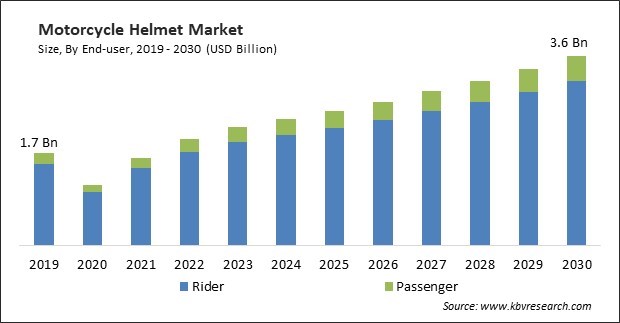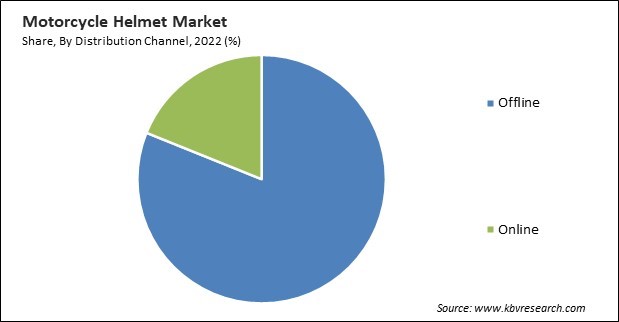The Global Motorcycle Helmet Market size is expected to reach $3.6 billion by 2030, rising at a market growth of 7.0% CAGR during the forecast period.
Different types of motorcycles are available, each with its riding style. This diversity leads to a variety of helmet preferences. For example, cruiser riders may prefer open-face helmets, while sportbike riders may opt for full-face helmets. Hence, the rider segment would acquire more than 83% share of the market by 2030. The market offers a range of helmet types to cater to various riding styles. As the motorcycle ownership base expands, competition among helmet manufacturers intensifies. This competition can lead to innovation, improved helmet technology, and a more comprehensive range of consumer options. Therefore, an increase in motorcycle ownership tends to positively influence the demand for motorcycle helmets and can drive growth in the market. Some of the factors impacting the market are implementation and growing awareness of safety regulations, increasing disposable income and motorcycle tourism, and non-compliance with helmet laws.

Safety awareness is closely intertwined with legislative measures and compliance with helmet laws. In regions where helmet use is mandated by law, heightened safety consciousness reinforces riders' compliance with these regulations. India has stringent helmet safety regulations that require all motorcycle riders and passengers to wear helmets conforming to the Indian Standards Institute (ISI) mark. Helmets must display the ISI mark to indicate compliance with safety standards. Similarly, Brazil has comprehensive helmet safety regulations. Helmets must meet the Brazilian National Standard (NBR 7471) and carry the Inmetro certification mark to ensure they comply with safety standards. When riders understand the life-saving benefits of helmets, they are more likely to adhere to helmet laws, further promoting safety on the road. Additionally, Motorcycle rallies and events, such as the Sturgis Motorcycle Rally in the United States or the Isle of Man TT races, attract riders worldwide. These events contribute to the growth of motorcycle tourism. Some travelers are choosing motorcycles as a more environmentally friendly mode of transport for tourism. Motorcycles typically have lower fuel consumption and emissions compared to cars. Some countries and regions have invested in improving road infrastructure, making it safer and more appealing for motorcycle tourists. Therefore, all these factors will aid in the expansion of the market.
However, some motorcycle riders prefer not to wear helmets despite the life-saving advantages. According to research from the National Center for Biotechnology Information, the most frequent excuses for not wearing a helmet are neck pain, restricted head mobility, asphyxia, and physical discomfort brought on by the heavy weight of the helmet. Due to the high cost of the product and relationships with high-end bike riders, premium and advanced motorcycle helmets also have a small consumer base. Therefore, all of these issues are projected to impede the expansion of the market throughout the coming years.
On the basis of distribution channel, the market is segmented into offline and online. The offline segment recorded the largest revenue share in the market in 2022. In emerging nations, supermarkets, convenience stores, and street sellers are the main distribution routes. Some local manufacturers offer their goods for sale offline at lower prices than those of upscale brands. Offline retailers often have knowledgeable staff who can assist customers in finding the right helmet size and fit. They can measure the head and recommend helmets that match specific requirements, ensuring a snug and secure fit for optimal safety and comfort.

Based on product, the market is divided into full face, open face, off-road/racing, and others. The open face segment procured a considerable growth rate in the market in 2022. A full-face helmet that does not have a chin bar is known as an open helmet. This helmet weighs less overall than a full-face helmet because it doesn't have a chin. Given that open-face helmets appear to be more well-liked by children and adults, demand for these types of helmets is anticipated to increase during the projection period. Additionally, merchants are utilizing the e-commerce platform to increase motorcycle helmet sales online through significant product discounts as well as promotions.
By end-user, the market is bifurcated into rider and passenger. The rider segment witnessed the maximum revenue share in the market in 2022. Helmets are primarily designed to protect the rider's head. They provide a barrier against impact, reducing the risk of head injuries in accidents or collisions. Helmets significantly reduce the probability of traumatic brain injuries (TBI) in accidents. The protective shell and impact-absorbing liner cushion the head, mitigating the impact force. Full-face helmets include visors or face shields that protect the rider's face and eyes from wind, debris, insects, and adverse weather conditions. This enhances visibility and prevents eye injuries.
| Report Attribute | Details |
|---|---|
| Market size value in 2022 | USD 2 Billion |
| Market size forecast in 2030 | USD 3.6 Billion |
| Base Year | 2022 |
| Historical Period | 2019 to 2021 |
| Forecast Period | 2023 to 2030 |
| Revenue Growth Rate | CAGR of 7% from 2023 to 2030 |
| Number of Pages | 211 |
| Number of Table | 340 |
| Report coverage | Market Trends, Revenue Estimation and Forecast, Segmentation Analysis, Regional and Country Breakdown, Companies Strategic Developments, Company Profiling |
| Segments covered | Product, End-user, Distribution Channel, Region |
| Country scope | US, Canada, Mexico, Germany, UK, France, Russia, Spain, Italy, China, Japan, India, South Korea, Singapore, Malaysia, Brazil, Argentina, UAE, Saudi Arabia, South Africa, Nigeria |
| Growth Drivers |
|
| Restraints |
|
Region-wise, the market is analyzed across North America, Europe, Asia Pacific, and LAMEA. The Asia Pacific region procured the highest revenue share in the market in 2022. Due to the substantial two-wheeler sector in nations like China, Indonesia, India, and Vietnam, the regional market is expanding. Major manufacturers are launching new goods to achieve maximum customer penetration in this region. The advent of electric two-wheelers has increased demand for helmets. Commuter motorcycles are driving the rise of the helmet sector and the bigger, more expensive two-wheelers. Additionally, the growth of rural infrastructure is fueling the purchase of two-wheelers, which is expected to increase demand for helmets.
Free Valuable Insights: Global Motorcycle Helmet Market size to reach USD 3.6 Billion by 2030
The market research report covers the analysis of key stake holders of the market. Key companies profiled in the report include Dainese S.p.A, HJC Helmets, SHOEI Co., Ltd., Alpinestars, Schuberth GmbH, STUDDS Accessories Limited, Caberg S.p.a., Fox Racing, Inc. (Vista Outdoor, Inc.), Manufacturas Tomas helmets (MT Helmets), and Shark SAS.
By End-user
By Product
By Distribution Channel
By Geography
This Market size is expected to reach $3.6 billion by 2030.
Implementation and growing awareness of safety regulations are driving the Market in coming years, however, Non-compliance with helmet laws restraints the growth of the Market.
Dainese S.p.A, HJC Helmets, SHOEI Co., Ltd., Alpinestars, Schuberth GmbH, STUDDS Accessories Limited, Caberg S.p.a., Fox Racing, Inc. (Vista Outdoor, Inc.), Manufacturas Tomas helmets (MT Helmets), and Shark SAS.
The Online segment has shown the high growth rate of 9.6% during (2023 - 2030).
The Full Face segment is leading the Market by Product in 2022 thereby, achieving a market value of $2 Billion by 2030.
The Asia Pacific region dominated the Market by Region in 2022, and would continue to be a dominant market till 2030; thereby, achieving a market value of $2 Billion by 2030.
Our team of dedicated experts can provide you with attractive expansion opportunities for your business.

